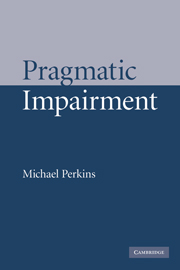Book contents
- Frontmatter
- Contents
- List of figures
- List of tables
- Acknowledgements
- Transcription conventions
- 1 Introduction
- 2 Pragmatic theory and pragmatic impairment
- 3 Pragmatics and modularity: components, dissociations and associations
- 4 Pragmatic ability and disability: an emergentist model
- 5 Cognition and pragmatics
- 6 Language and pragmatics
- 7 Sensorimotor systems and pragmatics
- 8 Compensatory adaptation
- 9 Conclusions
- Appendix
- References
- Index
6 - Language and pragmatics
Published online by Cambridge University Press: 22 September 2009
- Frontmatter
- Contents
- List of figures
- List of tables
- Acknowledgements
- Transcription conventions
- 1 Introduction
- 2 Pragmatic theory and pragmatic impairment
- 3 Pragmatics and modularity: components, dissociations and associations
- 4 Pragmatic ability and disability: an emergentist model
- 5 Cognition and pragmatics
- 6 Language and pragmatics
- 7 Sensorimotor systems and pragmatics
- 8 Compensatory adaptation
- 9 Conclusions
- Appendix
- References
- Index
Summary
Introduction
When asked to identify typical manifestations of pragmatic impairment, clinicians will invariably choose autistic spectrum disorder, right hemisphere brain damage and traumatic brain injury. The underlying causes of these disorders are usually seen as cognitive rather than linguistic, and their pragmatic nature as the effect they have on language use and comprehension or communication more generally. Although language and speech disorders are also regarded as potential contributory factors in pragmatic impairment in both children (McTear and Conti-Ramsden, 1992) and adults (Menn et al., 1995) they are not usually seen as being so central. In order to reflect this general perception, I have in earlier work (e.g. Perkins, 2000) proposed a classification scheme in which pragmatic impairments with a cognitive basis are described as primary, whereas those with a linguistic or sensorimotor basis are seen as secondary (see Table 6.1). In addition, impairments with multiple underlying causes (e.g. both cognitive and linguistic) would be labelled as complex.
Although such a classificatory framework may provide a convenient way of differentiating pragmatic impairments based on their aetiology, it is admittedly only a first step, in that it takes little account of the emergent nature of pragmatic impairment as described in Chapters 3 and 4 according to which any underlying dysfunction will have pragmatic consequences by virtue of disrupting the process of communicative choice.
- Type
- Chapter
- Information
- Pragmatic Impairment , pp. 107 - 138Publisher: Cambridge University PressPrint publication year: 2007



